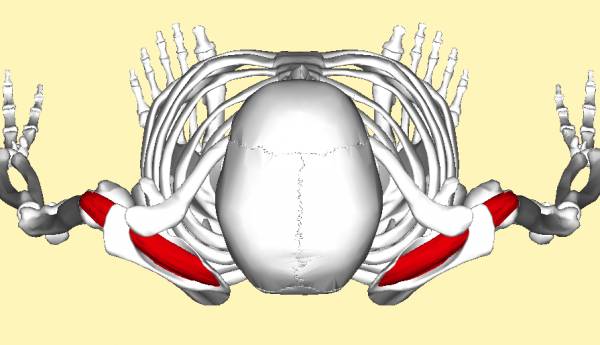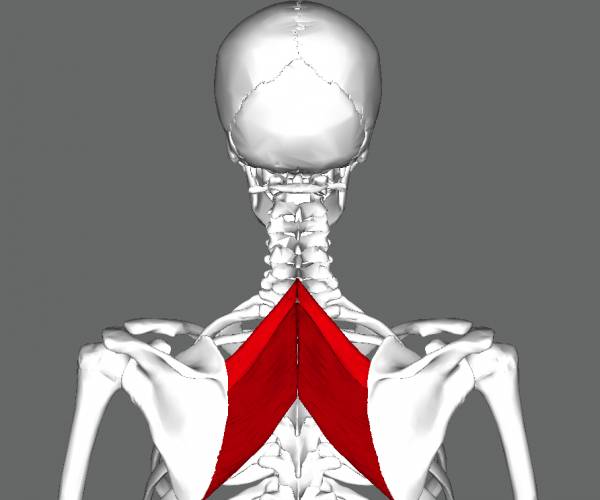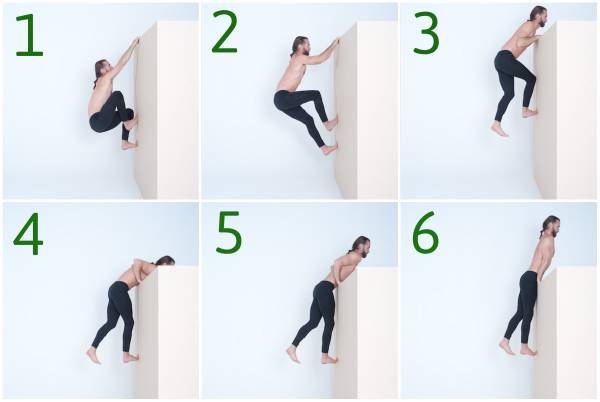Your ability to raise your arm above your head is dependent upon the healthy function of a major joint in your shoulder region – the glenohumeral joint. This is what most of us know as the “ball and socket joint” of the shoulder. It allows you to move your scapula in pretty much every direction.
The rotator cuff muscles are what support the glenohumeral joint. A lot of people think there’s just one rotator cuff, but guess what? You’ve actually got four of them.
A lot of people damage their rotator cuff because the big muscles supporting it aren’t in optimal shape.
They’re not very powerful muscles, and they are used to keep the arm in the socket, so a lot of people injure or tear a rotator cuff because the big muscles supporting the shoulder – like your latissimus, rhomboids, and serratus – are not working efficiently. This leaves you trying to use more of these stabilizing rotator cuff muscles for strength and power, and they don’t like that. So you end up injuring one or more rotator cuffs.
To keep your shoulders healthy and strong, I’m going to share with you:
- How to use manual therapy to improve your problem areas.
- Some basic and natural movements that will build shoulder strength.
The Supraspinatus
Of the four rotator cuff muscles, the supraspinatus is the main one people tend to injure, especially in any traumatic accident. Falling on your shoulder is a good way to tear this muscle. So, first things first, either don’t fall when you’re climbing or make sure to fall properly.
“[I]f you have a problem with the supraspinatus, look for a trigger point in that area (one of those big knots you feel). Work on that point and see if it helps you move your shoulder and arm more freely and with less pain.”
Your supraspinatus comes down from deep in your upper trap on top of your scapula – which is where most people want to have their shoulders rubbed after sitting in a chair and being stressed out all day – and inserts right into the top of the humerus. That’s your upper arm. So, if you have a problem with the supraspinatus, look for a trigger point in that area (one of those big knots you feel). Work on that point and see if it helps you move your shoulder and arm more freely and with less pain.

If you have a problem with the supraspinatus, look for a trigger point in that area.
The Other Three
Of the other three rotator cuff muscles, you’ve got the infraspinatus and the teres minor that allow you to externally rotate your upper arm. Then there is the subscapularis, which allows you to push down and forward. Think of it as lightly throwing something. Your subscapularis muscle is a bit like your armpit muscle, and it integrates with the serratus anterior to provide essential stability and motion to the scapula.
“This is a sore and sensitive area for most regardless of whether there’s an issue to be dealt with or not. Proceed slowly and be cautious of nerves.”
A lot of people who have pain deep in their shoulder or even their upper back are actually experiencing subscapularis problems. Working on the trigger point in front of the scapula, as well as in your armpit area, can provide dramatic results. Sounds fun, doesn’t it? How do you do determine if this is your problem?
Lay supine (on your back) and bring your upper arms out perpendicular to either side of you. Then, let your forearms fall back (ninety degree elbow hands facing up). Can your forearms touch the floor? Are they equal left to right? That range of motion is going to be most dependent on your subscapularis muscle. If you’re having issues, then look for trigger points up in your scapula and see what you find.
Beware: This is a sore and sensitive area for most regardless of whether there’s an issue to be dealt with or not. Proceed slowly and be cautious of nerves. If you experience numbness or tingling sensations, then move out of that area.
The Rhomboid
Another important muscle that stabilizes the shoulder blade is the rhomboid. These muscles attach the inner part of your shoulder blade to your spine and oppose the action of your serratus. This is where people would tend to say, “I have pain between my shoulder blades.”

If you feel pain when you try to move your arm toward or away from your body, your rhomboids may need work.
You could have pain anywhere in your shoulder blade as you move, but if the problem occurs when you try to move your upper arm toward or away from your body (rather than forward or backward), then the rhomboids may need some work. The trigger points are typically easy to find, as they’re right in between your shoulder blade and spine. You can roll on a tennis ball or ask your friend (or enemy, if you want it deep) to stick an elbow in that area.
A lot of times, the rhomboid that needs to be treated is on the side where you’re not feeling pain with movement. These muscles have to balance each other. So, if the right one is bothering you, the weakness might actually be on the left side and it’s causing the right one to spasm. Therefore, you want to treat the trigger points on the side of weakness.
Latissimus
You also have the large latissimus muscle attaching to the upper arm. This raises your arm up and helps you pull things down. Your latissimus muscle helps you both with shoulder motion and shoulder power. People think of their lats when they’re climbing, but as you know, it’s much more than just that muscle responsible for the natural motion of climbing.
Climbing is actually a great tool for keeping your shoulders strong and healthy. It will help you develop selective tension, improve your upper body strength, and improve the mobility of your shoulders. The climb up, as well as passive and active hanging will help develop your shoulder joints and especially the mobility of your glenohumeral joint.
How to Do the Climb Up

MovNat founder Erwan LeCorre demonstrates the climb up.
The climb up is used when hanging from a vertical surface, to extend yourself up and reach a higher point:
- From the hanging position, keep the arms lengthened and walk the balls of the feet
- towards knee or waist level. The higher you can place the feet, the greater the force you can
- be generated through the legs. Depending on the surface and the grip, the legs can be parallel or staggered, flexed or extended.
- From this setup, drive through the legs and feet (or push off the surface with the legs if beginning with the legs in extension).
- As the legs are extended, continue driving and generating force through the balls of the feet.
- Keeping the heels high, drive the hips forward and extend one or both arms to secure a higher point of support with the hand(s).
I also like to have my clients and patients rotate their shoulder blades in a full circle while hanging to develop full motion and strength, especially in the lats and rhomboids. Check out my video below – at 13:54, I show this motion.
The side swing traverse is the next essential Natural Movement skill to master, and then onto getting yourself up and over a horizontal bar. This is a rewarding accomplishment that will get your shoulders developed like no other drill. Plus it’s practical and you’ll look awesome doing it.
So crawl and climb, and then climb and crawl some more to develop, sustain, and rehabilitate your shoulders!
More Like This:
- How to Self-Diagnose Your Shoulder Pain
- The Dynamic Duo of Shoulder Impingement
- How to Crawl Your Way Back to Shoulder Health
- New on Pulse Beat Fit Today
Photo 1 courtesy of By Dr. Johannes Sobotta, via Wikimedia Commons.
Photo 2 by Anatomography, via Wikimedia Commons.
Photo 3 by Anatomography, via Wikimedia Commons.
Photo 4 courtesy of Erwan LeCorre, from “The Practice of Natural Movement.“






